Who, Kamala Harris or Donald Trump, will win what promises to be the most indecisive presidential election in the history of the United States? Americans are called to the polls on Tuesday, November 5, to decide between the Democratic vice-president and the Republican ex-president, neck and neck in the latest polls. The first results are expected from midnight French time. Our map, updated in real time, will allow you to discover the winner in each state. However, the final results and the name of the winner may take time to be known.
Select a state on the map to view results
Sources : Associated Press, CNN
In this election by indirect universal suffrage, Americans vote for a total of 538 electors, who designate the president. To access the White House, a candidate must win an absolute majority, that is to say reach the threshold of at least 270 electors. The rule of “winner takes it all” applies: the candidate who comes first in a state wins all the electors associated with it (with the exception of Maine and Nebraska).
>> Follow the American night and the results of the election in our live
But the outcome of the presidential race could be decided in seven particularly undecided states: Arizona, North Carolina, Georgia, Michigan, Nevada, Pennsylvania and Wisconsin. These pivotal states, called swing states in English, with a significant number of electors, can in fact switch to the Democratic or Republican side, and send a decisive number of electors to the two candidates. The map below will detail, in real time, the number of electoral votes sent by state to the winner.
Distribution of major voters
Sources : Associated Press, CNN
Our methodology
These two maps as well as the gauge are updated in real time by the franceinfo editorial staff, based on cross-checks between two sources: the Associated Press agency and CNN. For 44 states, we track AP results; in the seven key voting states, the two sources must be aligned for the result to be displayed. If the counting is in progress, the results of the States are displayed “pending”. When the sources contradict each other on a result or if one of the sources is particularly slow to give a result, the States concerned appear as “uncertain”.
If one side wins all the electors of a state, the color of its party is displayed. Maine and Nebraska are an exception: in these two states, the rule for distributing the electors differs, because several candidates can share them. They can therefore be colored in duotone.
Writing : Mathieu Lehot-Couette, Brice Le Borgne
Development : Valentin Pigeau
Design : Léa Girardot
Editorial oversight : Julie Rasplus, Camille Caldini, Benoît Zagdoun






